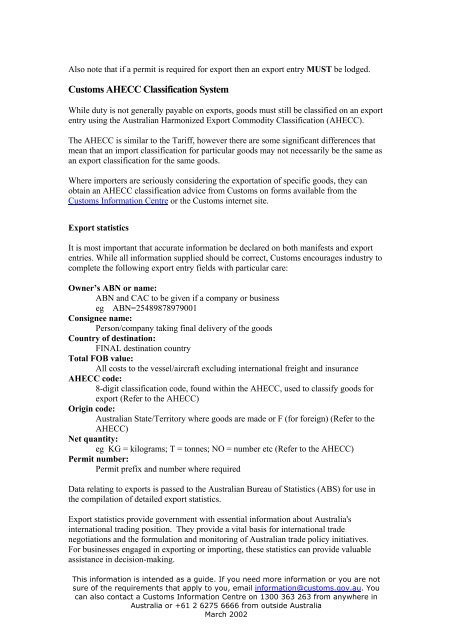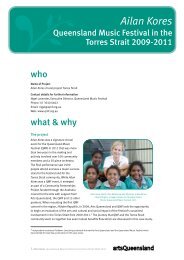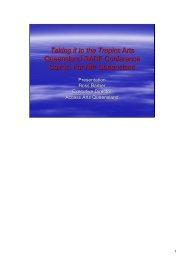Customs Guide to Importing and Exporting - Arts Queensland
Customs Guide to Importing and Exporting - Arts Queensland
Customs Guide to Importing and Exporting - Arts Queensland
You also want an ePaper? Increase the reach of your titles
YUMPU automatically turns print PDFs into web optimized ePapers that Google loves.
Also note that if a permit is required for export then an export entry MUST be lodged.<br />
<strong>Cus<strong>to</strong>ms</strong> AHECC Classification System<br />
While duty is not generally payable on exports, goods must still be classified on an export<br />
entry using the Australian Harmonized Export Commodity Classification (AHECC).<br />
The AHECC is similar <strong>to</strong> the Tariff, however there are some significant differences that<br />
mean that an import classification for particular goods may not necessarily be the same as<br />
an export classification for the same goods.<br />
Where importers are seriously considering the exportation of specific goods, they can<br />
obtain an AHECC classification advice from <strong>Cus<strong>to</strong>ms</strong> on forms available from the<br />
<strong>Cus<strong>to</strong>ms</strong> Information Centre or the <strong>Cus<strong>to</strong>ms</strong> internet site.<br />
Export statistics<br />
It is most important that accurate information be declared on both manifests <strong>and</strong> export<br />
entries. While all information supplied should be correct, <strong>Cus<strong>to</strong>ms</strong> encourages industry <strong>to</strong><br />
complete the following export entry fields with particular care:<br />
Owner’s ABN or name:<br />
ABN <strong>and</strong> CAC <strong>to</strong> be given if a company or business<br />
eg ABN=25489878979001<br />
Consignee name:<br />
Person/company taking final delivery of the goods<br />
Country of destination:<br />
FINAL destination country<br />
Total FOB value:<br />
All costs <strong>to</strong> the vessel/aircraft excluding international freight <strong>and</strong> insurance<br />
AHECC code:<br />
8-digit classification code, found within the AHECC, used <strong>to</strong> classify goods for<br />
export (Refer <strong>to</strong> the AHECC)<br />
Origin code:<br />
Australian State/Terri<strong>to</strong>ry where goods are made or F (for foreign) (Refer <strong>to</strong> the<br />
AHECC)<br />
Net quantity:<br />
eg KG = kilograms; T = <strong>to</strong>nnes; NO = number etc (Refer <strong>to</strong> the AHECC)<br />
Permit number:<br />
Permit prefix <strong>and</strong> number where required<br />
Data relating <strong>to</strong> exports is passed <strong>to</strong> the Australian Bureau of Statistics (ABS) for use in<br />
the compilation of detailed export statistics.<br />
Export statistics provide government with essential information about Australia's<br />
international trading position. They provide a vital basis for international trade<br />
negotiations <strong>and</strong> the formulation <strong>and</strong> moni<strong>to</strong>ring of Australian trade policy initiatives.<br />
For businesses engaged in exporting or importing, these statistics can provide valuable<br />
assistance in decision-making.<br />
This information is intended as a guide. If you need more information or you are not<br />
sure of the requirements that apply <strong>to</strong> you, email information@cus<strong>to</strong>ms.gov.au. You<br />
can also contact a <strong>Cus<strong>to</strong>ms</strong> Information Centre on 1300 363 263 from anywhere in<br />
Australia or +61 2 6275 6666 from outside Australia<br />
March 2002





